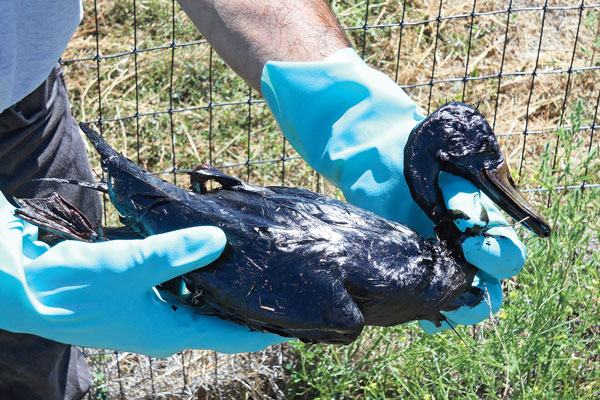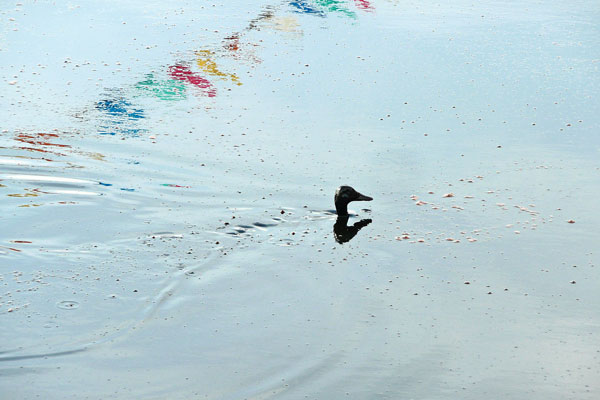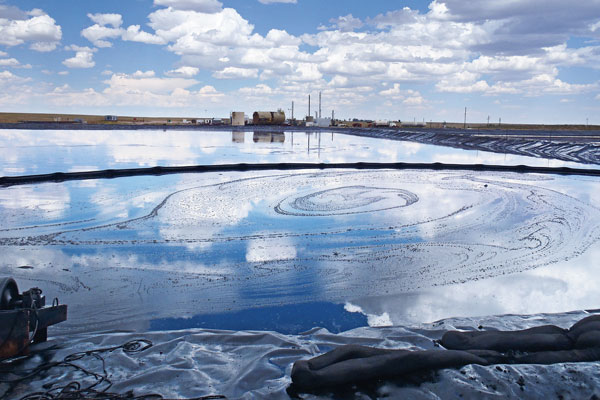November 04, 2014
By David Hart
 They look like any other body of water from above. Some are tiny ponds in the arid southwest. Others are 3,000-acre reservoirs in the boreal forest of Canada. Large or small, they have one thing in common: They are man-made death traps for birds and wildlife. Waste pits in America's oil fields and tailings ponds in the tar sands region of Canada have been killing ducks and other birds by the millions for decades.
They look like any other body of water from above. Some are tiny ponds in the arid southwest. Others are 3,000-acre reservoirs in the boreal forest of Canada. Large or small, they have one thing in common: They are man-made death traps for birds and wildlife. Waste pits in America's oil fields and tailings ponds in the tar sands region of Canada have been killing ducks and other birds by the millions for decades.
The issue is largely ignored in the U.S., but made international headlines in 2008 when more than 1,600 ducks perished after landing on a tailings pond in northeastern Alberta. The birds became coated in bitumen, a tar-like substance that is a source of oil.
Syncrude Canada was fined $3 million for the incident, the largest environmental fine in Canadian history, and agreed to take steps to deter birds from landing on the ponds. Just days after the court case ended in 2010, another 500 ducks died on a different tailings pond.
The 2008 incident led to a court-ordered study that looked at overall mortality of birds, effectiveness of deterrents and other issues related to the impact of tar sands extraction on water birds. Researchers found an estimated 200,000, including a large number of ducks, visited the ponds annually.
Advertisement
However, study leader Dr. Colleen Cassady St. Clair, a biology professor at the University of Alberta, estimates the actual number of birds that perish each year after landing on the ponds is likely no more than 2,000.
"When you look at the population-wide mortality from hunting, for instance, the number of ducks that died after landing on these tailings ponds was pretty insignificant," says St. Clair.
Separating oil from sand and dirt requires steam and a massive amount of water. Once the water goes through the extraction process, it is dumped into a tailings pond along with bitumen and other toxic materials that escape the filtering process. Some of the water then goes to a recycle pond and is used in the extraction process again.
Advertisement
So far, there are about 64 man-made ponds containing water affected by the mining process in the tar sands region. Environmental regulations prohibit releasing any of this water back into the environment. Oil companies have to build more waste ponds to keep up with the use. National Wildlife Federation senior counsel Jim Murphy says the various companies that work in the oil sands region are planning to triple production in the coming years.
"As long as the ponds exist, there is always the risk of another major event like the ones that took place in 2008 and 2010," says Murphy. "As production and the number of ponds goes up, so does the likelihood of catastrophic landing events."
Areas that contain bitumen pose a high risk to birds, but one study found the recycle ponds might be relatively safe for brief stop-overs. Elizabeth Beck, a graduate student working under St. Clair, placed juvenile and adult Pekin ducks in water taken directly from a recycle pond next to a tar sands processing plant. Young ducks were exposed for up to eight hours on three occasions; adults were allowed to swim in the water for eight hours on six occasions. Beck found little evidence of increased toxins in blood samples taken from the birds.
"There was virtually nothing to find," says St. Clair, who suggests deterrent efforts should be concentrated on the more dangerous areas.
Disappearing BOREAL
She doesn't dismiss the impact of tar sands extraction on waterfowl and other wildlife. After leading the implementation of a standardized monitoring program over the last three years, she says it is now possible to identify the best methods for keeping birds off the ponds.
 However, St. Clair says the bigger issue is the overall environmental impact. The tar sands are close to the earth's surface, so vast areas of forest are destroyed in the mining process. Murphy says about 1,200-square miles of habitat have been destroyed so far. That number is expected to increase dramatically in the coming years.
However, St. Clair says the bigger issue is the overall environmental impact. The tar sands are close to the earth's surface, so vast areas of forest are destroyed in the mining process. Murphy says about 1,200-square miles of habitat have been destroyed so far. That number is expected to increase dramatically in the coming years.
"This is high-quality habitat for a number of birds. Many species are already in decline. We also know the water and the toxins from the tailings ponds are leeching into nearby waters. Fish downstream from these ponds are developing high levels of tumors," says Murphy.
The good news is the region is not considered high-priority waterfowl habitat. It does serve as a migration corridor for all four flyways, though. The majority of ducks may fly past the tar sands tailing ponds on their way south, but they'll be greeted by a new threat when they cross the border.
U.S. Even Worse
Waste oil pits, which range from the size of a swimming pool to larger industrial ponds up to five acres, are scattered throughout the western U.S., killing far more birds than those in Canada.
The lagoons are dug near oil wells and hold oil, toxic water or both. Birds mistake the shining surface for water and are handed a virtual death sentence as soon as they land on it. Wildlife managers have examined the problem dating back to at least 1956 when a Wyoming Game & Fish researcher studied duck mortality on waste oil pits in the Bighorn Basin.
A report released by the U.S. Fish & Wildlife Service estimated as many as 2 million birds died each year after landing on waste oil pits in the U.S. prior to 1997. The problem has improved somewhat, says USFWS environmental contaminant specialist Pedro Ramirez Jr., but not by much. A 2006 study put the number of birds killed at 500,000 to 1 million annually.
 Ducks made up nearly half that number. The Service found the percentage of ducks killed in these ponds is likely higher during migration periods and thinks the numbers may go up even more during drought years when natural water sources dwindle. The decrease in bird deaths in waste oil ponds is largely the result of increased pressure from wildlife advocates and through inspection by FWS agents who enforce the Migratory Bird Treaty Act, which protects nearly 800 species of birds from illegal take.
Ducks made up nearly half that number. The Service found the percentage of ducks killed in these ponds is likely higher during migration periods and thinks the numbers may go up even more during drought years when natural water sources dwindle. The decrease in bird deaths in waste oil ponds is largely the result of increased pressure from wildlife advocates and through inspection by FWS agents who enforce the Migratory Bird Treaty Act, which protects nearly 800 species of birds from illegal take.
First-time offenders are typically given a warning and the opportunity to take measures to prevent future bird deaths. If an agent finds additional birds on repeat visits, he will issue a citation. Repeat offenders will be referred to the Department of Justice for prosecution. Smaller ponds can be covered with netting, which many producers have done.
It can be difficult to keep birds away from the larger ponds, though. The Service acknowledges that its agents are stretched thin and can't inspect every waste oil pit in their territories. Also, most states do not require oil companies to prevent birds from landing on waste ponds.
Even when a company is prosecuted, there's no guarantee the feds will win. A case in North Dakota against three oil and gas companies was dismissed after a judge ruled the MBTA did not apply to unintentional "take" as defined by the Act. Until something changes, ducks will continue to die in oil fields throughout North America.
Two thousand or even a half-million may seem like a drop in the bucket these days. American hunters killed nearly 19 million ducks in 2012 out of a total population of more than 48 million. The bumper crop may not last, though. Most habitat experts agree the Prairie Pothole Region is living on borrowed time.
Potholes are being drained at a record pace and the amount of nesting cover is rapidly shrinking. One dry year and we'll need all the extra ducks we can get.
